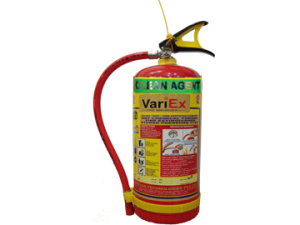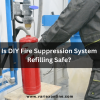![]()
Fire Immuniser
+91-7829629111
Email: info@variex.in
Varistor Technologies Pvt. Ltd.
Block-1, First Floor, Ardente Office One, Hoodi Circle, ITPL Main Road, Bengaluru, Karnataka 560048, IN
Clean Agent Fire Extinguisher Refilling Procedure
Introduction
Clean agent fire extinguishers are essential safety equipment used to extinguish fires without causing damage to sensitive equipment or leaving residue behind. These extinguishers are commonly found in data centers, laboratories, computer rooms, and other areas that contain valuable and sensitive equipment. However, once these extinguishers are used, they need to be refilled to ensure they are ready for future fire emergencies.
In this article, we will discuss the clean agent fire extinguisher refilling procedure. We will provide step-by-step instructions on how to properly refill these extinguishers, ensuring they are always in optimal working condition.
Step 1: Assess the Extinguisher
Before proceeding with the refilling procedure, it is important to assess the condition of the clean agent fire extinguisher. Check for any visible damage or signs of wear and tear. If the extinguisher shows any signs of damage, it should be inspected and repaired by a certified professional before refilling.
Step 2: Empty the Extinguisher
To begin the refilling process, you must first empty the clean agent fire extinguisher. Start by removing the safety pin or seal that prevents accidental discharge. Point the extinguisher away from yourself and others, and then press the trigger to discharge the remaining agent. Ensure that the extinguisher is fully emptied before proceeding to the next step.
Step 3: Disassemble the Extinguisher
Once the extinguisher is empty, it needs to be disassembled for thorough cleaning and inspection. Start by removing the head assembly or nozzle from the cylinder. Next, unscrew the valve assembly from the cylinder using a wrench or pliers. Make sure to wear protective gloves and eyewear during this step to prevent injury.
Step 4: Clean the Extinguisher Components
Cleaning the extinguisher components is a crucial part of the refilling process. Thoroughly rinse the cylinder, head assembly, valve assembly, and other parts with water. Use a brush or sponge to remove any debris or residue. Take extra care to clean the valve assembly and nozzle, as these areas often accumulate dirt and grime.
Step 5: Inspect for Damaged Parts
While cleaning the extinguisher components, carefully examine each part for any signs of damage or excessive wear. Pay close attention to the valve assembly, O-rings, and seals. Replace any damaged parts to ensure optimum performance and prevent potential leaks during the refilling process.
Step 6: Refill with Clean Agent
After the components have been cleaned and inspected, it is time to refill the clean agent fire extinguisher. The refill process requires specialized equipment and should only be performed by trained professionals. Contact a certified fire extinguisher servicing company to refill the extinguisher with the appropriate clean agent, such as FM-200 or Halon gas.
Step 7: Reassemble the Extinguisher
Once the clean agent has been added to the extinguisher, it is time to reassemble the components. Start by screwing the valve assembly back onto the cylinder, ensuring it is tightened securely. Then, reattach the head assembly or nozzle to the cylinder. Double-check that all the components are properly aligned and tightly secured.
Step 8: Recharge and Test
Once the extinguisher is reassembled, it needs to be recharged. This step involves pressurizing the cylinder with the appropriate amount of nitrogen or carbon dioxide, depending on the extinguisher type. The pressure should be within the recommended range specified by the manufacturer.
After recharging, conduct a final test to ensure the clean agent fire extinguisher is functioning correctly. Perform a visual inspection to confirm there are no leaks or damaged parts. Then, test the extinguisher by discharging a small amount of agent to verify that it is working properly.
Conclusion
Proper refill procedures are crucial to maintaining the effectiveness of clean agent fire extinguishers. Regular refilling ensures these extinguishers are always ready to protect valuable assets and people from fire emergencies. By following the step-by-step instructions outlined in this article, you can successfully refill clean agent fire extinguishers and keep them in optimal working condition.
Remember, safety should always be the primary concern when handling fire extinguishers. If you are unsure about any step in the refilling process or notice significant damage to the extinguisher, seek assistance from a certified professional.
Final Say
We at VariEx.in or Variexonline.com have mastered the art of designing, installing, inspecting, and fixing automatic sprinkler systems with the help of our in-house team, which is capable of delivering the fire sprinkler services you need, whether large or small and at affordable cost.
To schedule a fire sprinkler installation, or you think our services could benefit your commercial property, contact us online or give us a call at, 7829629111









